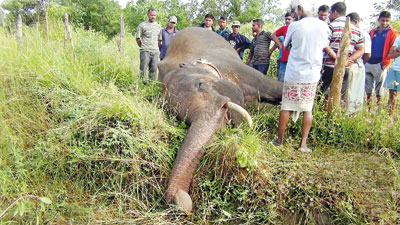News
Multi-pronged effort to save elephants from trains
Overhead passes, soundwave-emitting equipment, barricades and electronic warning systems are among a raft of recommendations issued by a ministerial committee appointed to look into ways to protect elephants against being hit and killed by trains.

A recent jumbo death in Polonnaruwa
The committee, which includes officials of the departments of railways and wildlife as well as an engineer, Iresh Perea, was appointed by the Transport Ministry.
It proposes that a centralised automatic observation centre be created to co-ordinate efforts to prevent elephant deaths on rail tracks.
At identified elephant crossings, tunnels and overpass systems should be constructed, depending on the geography of the area, to allow elephants to cross over or under tracks safely.
Barricades should be set up along parts of the track to direct elephants to these safer crossings.
A sensor system emitting low-frequency sound that repels elephants should be developed and set up at points along the track, the committee says in its report submitted this week.
Another recommendation is to instal an electronic warning system to alert train drivers to the presence of elephants on or near the tracks.
The committee suggests that vegetation close to the tracks be cleared to allow train drivers better vision of animals approaching tracks.
The bed of rock on which rail lines are laid should be improved to prevent elephants from getting their feet stuck in between sleepers and thus unable to escape an oncoming train.
Only experienced locomotive drivers should be rostered on night trains, where elephants are most at risk from being hit, the committee said. The locomotives should be fitted with high-powered LED lights along with primary lights.
Drivers should also be equipped with, and ordered to use, thermal cameras which can spot animals up to 750m along the track, and electronic sensor-based early warning systems that would keep beeping until the train slows down.
Drivers should keep in regular contact with stationmasters while travelling, and exchange information on the current situation.
Other suggestions include planting food and improving water supplies within parks and removing privately-erected electric fences alongside elephant paths.
The committee was formed following recent tragedies along the tracks. On September 18, three female elephants and an unborn calf were hit and killed by a train; on October 6, two calves and a pregnant elephant were run over; on October 9, another elephant was hit and killed after a collision with the Batticaloa-Colombo “Meenagaya” train; on October 21, two elephants were hit by a Jaffna-bound train, with one losing its life and the other being critically injured.

